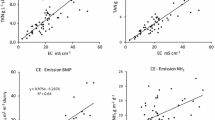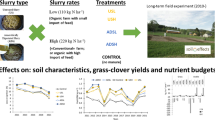Abstract
Ammonia losses were investigated from broadcast, band-spread andinjected untreated cattle slurry, broadcast aerated slurry and broadcastseparated slurry (liquid fraction). The slurries were applied on ley after thefirst cut at an application rate of 33 to 62 Mgha−1 including about 80 kgha−1 ammoniacal nitrogen. Slurries were analysed andammonia emission was measured with a micrometeorological chamber method on theday of application and on the following two days. Separation lowered the drymatter content of slurries by an average of 37% but aeration had no significanteffect. Aeration reduced the ammoniacal nitrogen content by an average of 12%.About half of the ammoniacal nitrogen of broadcast slurries was lost throughammonia volatilization, but injection of slurry into the ground preventedammonia losses almost totally. Band spreading retarded ammonia volatilizationonthe day of application, but total emissions were not significantly differentfrom broadcast slurry. Ammonia volatilization from neither aerated norseparatedslurry differed significantly from broadcast untreated slurry. However, in somecases the volatilization of ammonia was lower from the separated slurry,whereasthe highest volatilization was measured from aerated slurry. Injection ofslurryinto the ground proved to be far more effective in preventing ammonia emissionthan the reduction of either surface area or dry matter content of surfaceapplied slurry.
Similar content being viewed by others
References
Braschkat J., Mannheim T. and Marschner H. 1997. Estimation of ammonia losses after application of liquid cattle manure on grassland. Z. Pflanzenernähr Bodenk. 160: 117–123.
Clemens J., Vandré R., Kaupenjohann M. and Goldbach H. 1997. Ammonia and nitrous oxide emissions after landspreading of slurry as influenced by application technique and dry matterdue reduction. II. Short term nitrous oxide emissions. Z. Pflan-zenernähr Bodenk. 160: 491–496.
Ferm M., Kasimir-Klemedtsson Å., Weslien P. and Klemedtsson L. 1999. Emission of NH3 and N2O after spreading of pig slurry by broadcasting or band spreading. Soil Use Manag. 15: 27–33.
Ferm M. and Svensson L. 1992. A new approach to estimate ammonia emissions in Sweden. In: Klaassen G. (ed.), Ammonia Emissions in Europe: Emission Coefficients and Abatement Costs, Proceedings of IIASA-workshop. Laxenburg, Austria, 4–6 February 1991, pp. 109–125.
Frost J.P., Stevens R.J. and Laughlin R.J. 1990. Effect of separation and acidification of cattle slurry on ammonia volatilization and on the efficiency of slurry nitrogen for herbage production. J. Agric. Sci. 115: 49–56.
Frost J.P. 1994. Effect of spreading method, application rate and dilution on ammonia volatilization from cattle slurry. Grass Forage Sci. 49: 391–400.
Kähäri J. and Nissinen H. 1978. The mineral element contents of timothy (Phleum pratense L.) in Finland. I. Acta Agric. Scand. 20: 26–39.
Kapuinen P. 1998. A light liquid manure injector for grasslands in polar farming. In: Chastain J.P. (ed.), Fourth International Dairy Housing Conference, Conference Proceedings. ASAE publication 01-98, pp. 346–354.
Kemppainen E. 1989. Nutrient content and fertilizer value of livestock manure with special reference to cow manure. Ann. Agric. Fennica 28: 163–284.
Kjellerup V. 1986. Agros nitrogen meter for estimation of ammonium nitrogen in slurry and liquid manure. In: Dam Kofoed A. et al. (eds), Efficient Land Use of Sludge and Manure. Elsevier, London, pp. 216–233.
Leinonen P., Heinonen-Tanski H. and Rinne K. 1998. Nitrogen economy of cattle slurry aeration and spreading on to grassland. Acta Agric. Scand. Sect. B Soil Plant Sci. 48: 65–72.
Malgeryd J. 1996. Åtgärder för att minska ammoniakemissionerna ¨ vid spridning av stallgodsel [Measures to reduce ammonia emissions following application of animal manure]. JTI-rapport, Lantbruk & Industri nr 229, 126 pp. Swedish Institute of Agricultural Engineering, Uppsala (in Swedish, summary in English).
Mattson M., Husted S. and Schjoerring J.K. 1998. Influence of nitrogen nutrition and metabolism on ammonia volatilization in plants. Nutr. Cycling Agroecosyst. 51: 35–40.
Misselbrook T.H., Laws J.A. and Pain B.F. 1996. Surface applica-tion and shallow injection of cattle slurry on grassland: nitrogen losses, herbage yields and nitrogen recoveries. Grass Forage Sci. 51: 270–277.
Morken J. 1992.Ammoniakktap etter tilføring av husdyrgjødsel i eng – Invirkning av tilføringsteknikk og gjødseltype [Ammonia losses after application of slurry to grassland The effect of application techniques and type of slurry]. Norsk lantbruksforsk-ing 6 (in Norwegian, summary in English): 315–329.
Pain B.F., Phillips V.R., Clarkson C.R., Misselbrook T.H., Rees Y.J. and Farrent J.W. 1990.Odour and ammonia emissions following the spreading of aerobically-treated pig slurry on grassland. Biol. Wastes 34: 149–160.
Reitz P., Gallmann E. and Kutzbach H.D. 1999. Measurement of ammonia emissions after slurry application to grassland: in-fluence of application techniques. Int. Agrophys. 13: 149–155.
Rubæk G.H., Henriksen K., Petersen J., Rasmussen B. and Sommer S.G. 1996. Effects of application technique and anaerobic digestion on gaseous nitrogen loss from animal slurry applied to ryegrass (Lolium perenne). J. Agric. Sci. 126: 481–492.
SAS Institute Inc. 1990. SAS/STAT User's Guide. 4th edn,Vol. 2. SAS Institute Inc., Cary, North Carolina.
Schulze E.-D., de Vries W., Hauhs M., Rosén K., Rasmussen L., Tamm C.-O. et al. 1989. Critical loads for nitrogen deposition on vatkomposforest ecosystems. Water Air Soil Pollut. 48: 451–456.
Steel R.G.D. and Torrie J.H. 1981. Principles and Procedures of Statistics. 2nd edn. McGraw-Hill, Singapore.
Svensson L. 1994a. A new dynamic chamber technique for measur-ing ammonia emissions from land-spread manure and fertilizers. Acta Agric. Scand., Sect. B, Soil Plant Sci. 44: 35–46.
Svensson L. 1994b. Ammonia volatilization following application of livestock manure to arable land. J. Agric. Eng. Res. 58: 241–260.
Thompson R.B., Ryden J.C. and Lockyer D.R. 1987. Fate of nitrogen in cattle slurry following surface application or injection to grassland. J. Soil Sci. 38: 689–700.
Thompson R.B., Pain B.F. and Rees Y.J. 1990. Ammonia volatiliza-tion from cattle slurry following surface application to grassland. II. Influence of application rate, wind speed and applying slurry in narrow bands. Plant Soil 125: 119–128.
Tveitnes S. and Håland Å. 1989. Gjødselverknaden av våtkomposforest tert og ubehandla blautgjødsel [The effect of wet composted and untreated cattle slurry on grassland]. Norsk landbruksforskning 3 (in Norwegian, summary in English): 211–216.
Van Breemen N., Burrough P.A., Velthorst E.J., van Dobben F.F., de Wit T., Ridder T.B. et al. 1982. Soil acidification from atmos-pheric ammonium sulphate in forest canopy throughfall. Nature 299: 548–550.
Author information
Authors and Affiliations
Rights and permissions
About this article
Cite this article
Mattila, P., Joki-Tokola, E. Effect of treatment and application technique of cattle slurry on its utilization by ley: I. Slurry properties and ammonia volatilization. Nutrient Cycling in Agroecosystems 65, 221–230 (2003). https://doi.org/10.1023/A:1022619304798
Issue Date:
DOI: https://doi.org/10.1023/A:1022619304798




